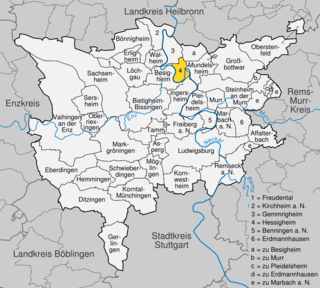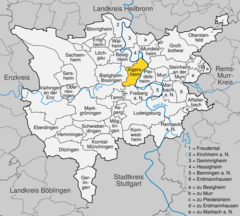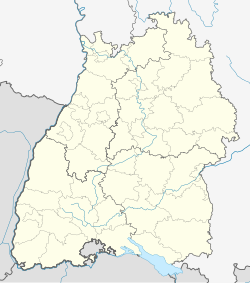Landkreis Heilbronn is a Landkreis (district) in the north of Baden-Württemberg, Germany. Neighboring districts are Neckar-Odenwald, Hohenlohe, Schwäbisch Hall, Rems-Murr, Ludwigsburg, Enz, Karlsruhe and Rhein-Neckar. In the centre of it is the free-city of Heilbronn, which is its own separate administrative area.
Landkreis Ludwigsburg is a Landkreis (district) in the middle of Baden-Württemberg, Germany. Neighboring districts are Heilbronn, Rems-Murr-Kreis, the district-free city Stuttgart, and the districts Böblingen and Enz-Kreis.

Allmersbach im Tal is a municipality in the Rems-Murr district of Baden-Württemberg, Germany. It belongs to the Stuttgart Region and to the boundary area of the Stuttgart Metropolitan Region.

Marbach am Neckar is a town about 20 kilometres north of Stuttgart. It belongs to the district of Ludwigsburg, the Stuttgart region and the European metropolitan region of Stuttgart. Marbach is known as the birthplace of Friedrich Schiller, to whom it owes the additional designation of Schiller City, which it has officially held since 2022.[2] The town is home to the Schiller National Museum, the German Literature Archive and the Modern Literature Museum.

Neckarwestheim is a municipality with 3524 inhabitants in the Heilbronn district, Baden-Württemberg, in south-west Germany. It is located on the Neckar river and is well known as the location of a nuclear power station, the Neckarwestheim Nuclear Power Plant.

Fellbach is a mid-sized town on the north-east edge of Stuttgart in Baden-Württemberg, Germany. With a population of approximately 45.430 as of December 2020 is the second largest town in the District Rems-Murr-Kreis. The area of the town is 27.7 km2 (10.7 sq mi).

Horb am Neckar is a town in the southwest of the German state of Baden-Württemberg. It is located on the Neckar river, between Offenburg to the west and Tübingen to the east. It has around 25,000 inhabitants, of whom about 6,000 live in the main town of Horb, and the remainder in 18 associated villages and districts which form part of the same municipality. If the entire municipality is counted, it is the largest town in the District of Freudenstadt.

Mundelsheim is a municipality in the German state of Baden-Wuerttemberg. It is located in the Ludwigsburg district, about 30 km north of Stuttgart and 20 km south of Heilbronn, on the Neckar river. It belongs to the Stuttgart Metropolitan Region.

Hessigheim is a municipality in the Ludwigsburg district of Baden-Württemberg, Germany.

Affalterbach is a municipality in the Ludwigsburg district in Baden-Württemberg, Germany.

Eberdingen is a municipality in the district of Ludwigsburg in Baden-Württemberg, Germany.

Bietigheim-Bissingen is the second-largest town in the district of Ludwigsburg, Baden-Württemberg, Germany with 42,515 inhabitants in 2007. It is situated on the river Enz and the river Metter, close to its confluence with the Neckar, about 19 km north of Stuttgart, and 20 km south of Heilbronn.

Löchgau is a municipality in the Ludwigsburg district of Baden-Württemberg, Germany.

Deißlingen is a municipality of the district of Rottweil of Baden-Württemberg, Germany.

Murr is a municipality in the district of Ludwigsburg, Baden-Württemberg, Germany. It is situated on the river Murr, 2 km upstream from its confluence with the Neckar and about 9 km northeast of Ludwigsburg.

Altbach is a municipality in the district of Esslingen in Baden-Württemberg. It belongs to the Stuttgart Region. and the European Metropolitan Region Stuttgart.

Hattenhofen is a municipality in the district of Göppingen in Baden-Württemberg in southern Germany.

Erligheim is a municipality in the district of Ludwigsburg in Baden-Württemberg in Germany.

Freiberg (Neckar) station (called Beihingen-Heutingsheim until 31 May 1975) is located at 19.4 kilometre point of the Backnang–Ludwigsburg railway and is a station of the Stuttgart S-Bahn. Until the end of World War II it was connected by a line to Bietigheim, which was formally closed on 15 January 1958.

Neckar-Zaber is an electoral constituency represented in the Bundestag. It elects one member via first-past-the-post voting. Under the current constituency numbering system, it is designated as constituency 266. It is located in northern Baden-Württemberg, comprising the southern part of the Landkreis Heilbronn district and the northern part of the Ludwigsburg district.

























